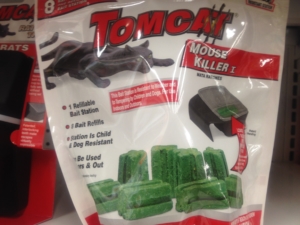If you have any reason to suspect your pet has ingested something toxic, please contact your veterinarian or one of the other resources listed:
• ASPCA Animal Poison Control Center 24-hour hotline at (888) 426-4435
• Pet Poison Helpline® 24-hour animal poison control service at (855) 764-7661
Bromethalin Rodenticides

Bromethalin-containing rodenticides are toxic to all animals, especially cats. Toxicity mainly occurs due to cerebral edema. It’s important to note that anticoagulant rodenticides also have a risk of toxicity if ingested.
Signs and symptoms of toxicity: Clinical signs of toxicity in dogs include weakness, paralysis, tremors, seizures, and coma. Cats are more prone to show paralytic signs of toxicity.
Toxic consumption: In dogs, ingestion of 2.5 mg/kg (1.1 mg/lb) of bromethalin can be fatal. In cats, the toxic threshold is lower at 0.45 mg/kg (0.2 mg/lb).
| X-Small Yorkie, Chihuahua |
Small Pug, Boston Terrier, Poodle |
Medium Beagle, Scottish Terrier |
Large Boxer, Cocker Spaniel |
X-Large Retriever, German Shepherd |
XX-Large Great Dane, St. Bernard |
| 1 – 10 lbs. (0.45 – 4.6 kg) |
11 – 25 lbs. (5 – 11.4 kg) |
26 – 40 lbs. (11.8 – 18.2 kg) |
41 – 70 lbs. (18.6 – 31.8 kg) |
71 – 90 lbs. (32.3 – 40.9 kg) |
91 – 110 lbs. (41.4 – 50 kg) |
 |
 |
 |
 |
 |
 |
| > 1.1 mg | > 12 mg | > 29 mg | > 46 mg | > 80 mg | > 103 mg |
| Most Cats | Large Cats |
| 1 – 10 lbs. (0.45 – 4.6 kg) |
11 – 25 lbs. (5 – 11.4 kg) |
 |
 |
| > 0.2 mg | > 2.2 mg |
References:
Osweiler, G, et al. (2011). Blackwell’s five-minute veterinary consult clinical companion. Small Animal Toxicology. [Kindle version]. Retrieved from Amazon.com
Pet Poison Control is provided free as a public service by the American College of Veterinary Pharmacists. Today we’re asking you to support us with a small donation. If you would like to dedicate your gift in honor or memory of a pet or individual, you will have that option before checkout. Your gift of any amount helps us maintain this resource and make it available to the pharmacy and veterinary communities. Thank you!





